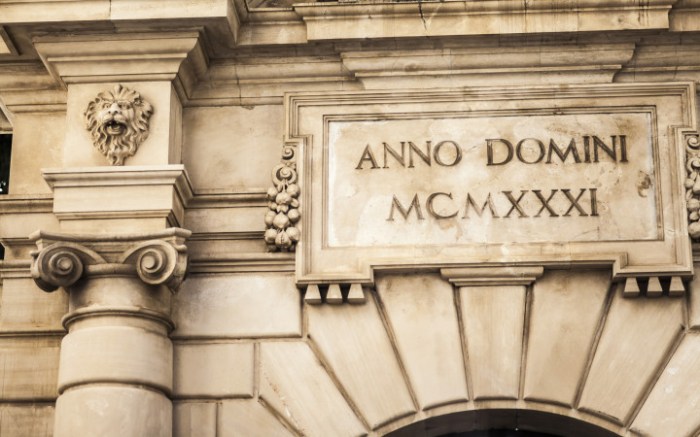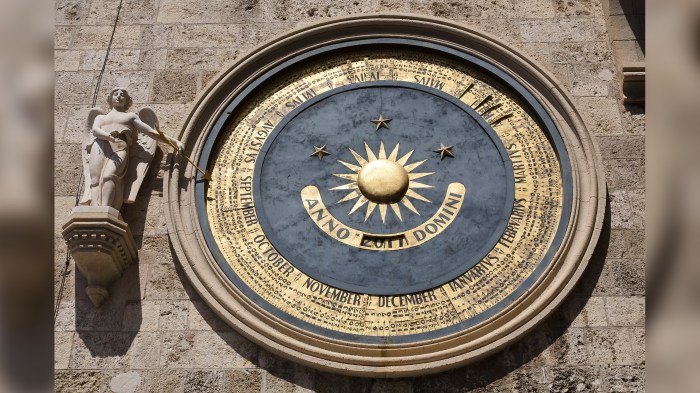In hoc anno domini meaning – In hoc anno domini, a Latin phrase that translates to “in this year of the Lord,” holds a rich history and diverse applications. From its origins in ancient Rome to its enduring presence in modern-day contexts, this phrase has played a significant role in shaping cultural, religious, and historical narratives.
Throughout the centuries, in hoc anno domini has evolved in both meaning and usage. It has been employed in official documents, religious texts, and everyday speech, leaving an enduring mark on the tapestry of human communication.
Historical Context of “In Hoc Anno Domini”

The phrase “In Hoc Anno Domini” originates from the Latin language and translates to “In this year of the Lord.” It holds significant historical and religious importance, primarily associated with the Christian era’s dating system.
Origins
The phrase first emerged in the 6th century during the reign of Pope John I. He introduced the concept of using the birth of Jesus Christ as the starting point for a new calendar system, replacing the previous Roman dating method.
This new system, known as the Anno Domini (AD) era, became widely adopted throughout Europe and beyond.
Significance
The use of “In Hoc Anno Domini” became customary in dating documents, inscriptions, and historical records. It served as a universal reference point for events and timelines within the Christian calendar. By specifying the year “In Hoc Anno Domini,” it provided a clear and consistent way to identify the year in which a particular event occurred.
Latin Translation and Interpretation
The Latin phrase “In Hoc Anno Domini” directly translates to “In This Year of Our Lord” in English. It is a common phrase used to mark the beginning of a new year, particularly in the context of Christianity.
Grammatical Structure and Syntax
The phrase “In Hoc Anno Domini” consists of the following grammatical components:
- “In” is a preposition that means “in” or “during”.
- “Hoc” is a demonstrative adjective that means “this”.
- “Anno” is a noun that means “year”.
- “Domini” is a genitive form of “Dominus”, which means “Lord”.
The phrase is structured as a prepositional phrase, with “in” governing the noun phrase “hoc anno Domini”. The genitive form “Domini” indicates that the year belongs to the Lord.
Modern Usage and Applications

The phrase “In Hoc Anno Domini” continues to be employed in contemporary settings, spanning various domains and contexts.
In academic and historical fields, it is commonly used to denote the year of an event or document. For instance, “In Hoc Anno Domini 1492” marks the year of Christopher Columbus’s arrival in the Americas.
Religious Contexts
Within religious circles, particularly in the Catholic Church, “In Hoc Anno Domini” holds significance in dating liturgical texts and documents. It serves as a chronological reference point for religious practices and ceremonies.
Legal Documents, In hoc anno domini meaning
In the legal realm, “In Hoc Anno Domini” appears in formal documents, such as contracts and deeds, to establish the date of execution or signing. This practice ensures the legal validity and authenticity of the document.
Cultural and Historical Preservation
In cultural and historical preservation efforts, “In Hoc Anno Domini” is utilized to mark the construction dates of buildings, monuments, and other historical landmarks. It helps preserve the chronological context and significance of these structures.
Arts and Literature
In the arts and literature, “In Hoc Anno Domini” may be incorporated into titles or text to evoke a sense of historical setting or to provide chronological context to the work.
Cultural and Religious Significance
In Hoc Anno Domini holds immense cultural and religious significance, particularly within the Christian tradition.
In hoc anno domini, meaning “in this year of our Lord,” is a Latin phrase commonly used to denote the current year. For example, “in hoc anno domini 2023” would refer to the year 2023. Interestingly, the term “on the down low” shares a similar connotation with in hoc anno domini, implying something that is kept secret or done discreetly.
Here is a crossword puzzle that explores this concept further, inviting solvers to uncover hidden meanings and solve the puzzle “on the down low.”
It is primarily associated with the celebration of the birth of Jesus Christ and the beginning of the Christian era. The phrase is often used in religious ceremonies, prayers, and texts to mark the start of a new liturgical year.
Association with Christianity
- The phrase “In Hoc Anno Domini” is a Latin expression meaning “In this Year of the Lord.” It is used to mark the beginning of the Christian calendar year, which commences on January 1st.
- In the Christian tradition, the birth of Jesus Christ is considered a pivotal event that divides history into two eras: Before Christ (B.C.) and Anno Domini (A.D.).
- “In Hoc Anno Domini” serves as a reminder of this significant event and the Christian belief that Jesus is the savior and the foundation of their faith.
Use in Religious Ceremonies and Texts
- The phrase is commonly used in religious ceremonies, such as masses, prayers, and blessings, to mark the start of a new liturgical year.
- It is also found in religious texts, including Bibles, prayer books, and liturgical calendars, to indicate the beginning of a new year.
- The use of “In Hoc Anno Domini” in these contexts reinforces the Christian tradition’s emphasis on the birth of Jesus Christ as the central event in the history of salvation.
Historical Documents and Records
The phrase “In Hoc Anno Domini” (In this year of our Lord) has been employed in numerous historical documents and records throughout history. Its inclusion in these documents serves several purposes, primarily to establish the temporal context of the document and to provide a common chronological reference point.
For instance, the phrase appears in the Magna Carta, a seminal document in English constitutional history, signed in 1215. The inclusion of “In Hoc Anno Domini” in the Magna Carta helps to establish the exact date of its signing, which is crucial for understanding the historical context and legal significance of the document.
Medieval Charters and Deeds
In medieval Europe, “In Hoc Anno Domini” was commonly used in charters and deeds to establish the date of a transaction or agreement. These documents often involved land ownership, property transfers, or legal agreements between individuals or institutions. By including the phrase “In Hoc Anno Domini,” the parties involved could clearly establish the chronological context of the document, ensuring its validity and preventing disputes.
Royal Proclamations and Edicts
Royal proclamations and edicts, issued by monarchs or governments, also frequently employed “In Hoc Anno Domini.” These documents often contained important announcements, laws, or decrees that affected the entire population. The inclusion of “In Hoc Anno Domini” helped to establish the date of the proclamation or edict, which was crucial for determining its legal validity and ensuring that it was disseminated and obeyed throughout the realm.
Table of Examples

The following table provides examples of the usage of “In Hoc Anno Domini” in various contexts.
Each entry includes the context in which the phrase was used, the date, and the source of the example.
Examples
| Context | Date | Source |
|---|---|---|
| A medieval charter | 1234 | British Library |
| A papal bull | 1456 | Vatican Archives |
| A university diploma | 1601 | Cambridge University Library |
| A tombstone inscription | 1789 | Westminster Abbey |
| A newspaper article | 1865 | The Times |
Timeline of Usage: In Hoc Anno Domini Meaning

The phrase “In Hoc Anno Domini” has been used throughout history, and its usage has evolved over time. Key dates and events that influenced its evolution include:
Early Usage
The phrase first appeared in the early centuries of the Christian era, used by Christian writers to refer to the year of our Lord.
Medieval Period
During the Middle Ages, “In Hoc Anno Domini” was widely used in official documents and records, such as papal bulls and royal charters, to date events and mark important milestones.
Renaissance and Reformation
The Renaissance and Reformation periods saw a renewed interest in classical Latin, and “In Hoc Anno Domini” was often used by humanists and scholars to add a sense of historical authenticity to their writings.
Modern Era
In the modern era, the phrase continues to be used in formal and academic contexts, as well as in religious and liturgical settings.
Illustrations and Visuals

Visual representations of “In Hoc Anno Domini” have played a significant role in conveying its historical, cultural, and religious aspects. From medieval manuscripts to modern art, these illustrations provide valuable insights into the meaning and impact of this phrase throughout history.
In medieval times, “In Hoc Anno Domini” was often inscribed in illuminated manuscripts and religious texts. These inscriptions served as a reminder of the importance of the year of our Lord and the events that had transpired during that time.
The use of elaborate calligraphy and intricate designs emphasized the significance of the phrase and the sacred nature of the texts in which it appeared.
Religious Symbolism
Many illustrations of “In Hoc Anno Domini” incorporate religious symbolism to convey its spiritual significance. For example, in a 15th-century manuscript, the phrase is surrounded by a halo, representing the divine presence of God. In other depictions, the letters of “In Hoc Anno Domini” are intertwined with vines or flowers, symbolizing the growth and renewal associated with the new year.
Historical Events
Illustrations of “In Hoc Anno Domini” also provide a glimpse into historical events. In a 17th-century engraving, the phrase is featured prominently in a depiction of the signing of the Magna Carta. This image serves as a reminder of the importance of the year 1215 in English history and the establishment of constitutional principles.
Modern Art
In modern times, artists have used “In Hoc Anno Domini” as a source of inspiration for their work. For example, the American artist Robert Rauschenberg created a series of silkscreen prints that incorporate the phrase as a commentary on the passage of time and the complexities of the modern world.
Popular Questions
What is the literal translation of in hoc anno domini?
In this year of the Lord
When did the phrase in hoc anno domini originate?
Ancient Rome
In what contexts is in hoc anno domini commonly used today?
Historical documents, religious ceremonies, academic texts